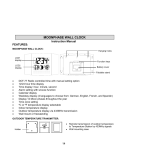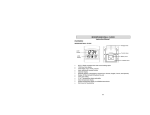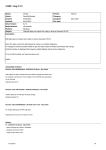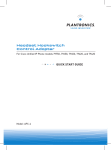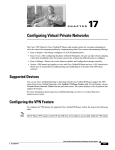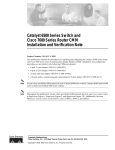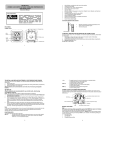Download Cisco Systems OL-15790-01 User's Manual
Transcript
CH A P T E R 6 Customizing the Cisco Unified IP Phone This chapter explains how you customize configuration files, phone ring sounds, background images, and other phone features. This chapter includes these topics: • Customizing and Modifying Configuration Files, page 6-1 • Creating Custom Phone Rings, page 6-2 • Creating Custom Background Images, page 6-3 • Configuring Wideband Codec, page 6-6 • Configuring the Idle Display, page 6-7 • Automatically Disabling the Cisco Unified IP Phone Touchscreen, page 6-7 Customizing and Modifying Configuration Files You can modify configuration files (for example, edit the xml files) and add customized files (for example, custom ring tones, call back tones, phone backgrounds) to the TFTP directory. You can modify files and add customized files to the TFTP directory in Cisco Unified Communications Operating System Administration, from the TFTP Server File Upload window. Refer to Cisco Unified Communications Operating System Administration Guide for information about how to upload files to the TFTP folder on a Cisco Unified Communications Manager server. You can obtain a copy of the Ringlist.xml and List.xml files from the system by using the following admin command-line interface (CLI) “file” commands: • admin:file – file list* – file view* – file search* – file get* – file dump* – file tail* – file delete* Cisco Unified IP Phone 7975G Administration Guide for Cisco Unified Communications Manager 7.0 (SCCP and SIP) OL-15790-01 6-1 Chapter 6 Customizing the Cisco Unified IP Phone Creating Custom Phone Rings Creating Custom Phone Rings The Cisco Unified IP Phone ships with two default ring types that are implemented in hardware: Chirp1 and Chirp2. Cisco Unified Communications Manager also provides a default set of additional phone ring sounds that are implemented in software as pulse code modulation (PCM) files. The PCM files, along with an XML file (named Ringlist.xml) that describes the ring list options that are available at your site, exist in the TFTP directory on each Cisco Unified Communications Manager server. For more information, see the “Cisco TFTP” chapter in Cisco Unified Communications Manager System Guide and the “Software Upgrades” chapter in Cisco Unified Communications Operating System Administration Guide. The following sections describe how you can customize the phone rings that are available at your site by creating PCM files and editing the Ringlist.xml file: • Ringlist.xml File Format Requirements, page 6-2 • PCM File Requirements for Custom Ring Types, page 6-3 • Configuring a Custom Phone Ring, page 6-3 Ringlist.xml File Format Requirements The Ringlist.xml file defines an XML object that contains a list of phone ring types. This file can include up to 50 ring types. Each ring type contains a pointer to the PCM file that is used for that ring type and the text that will appear on the Ring Type menu on a Cisco Unified IP Phone for that ring. The Cisco TFTP server for each Cisco Unified Communications Manager contains this file. The CiscoIPPhoneRinglist XML object uses the following simple tag set to describe the information: <CiscoIPPhoneRingList> <Ring> <DisplayName/> <FileName/> </Ring> </CiscoIPPhoneRingList> The following characteristics apply to the definition names. You must include the required DisplayName and FileName for each phone ring type. Note • DisplayName defines the name of the custom ring for the associated PCM file that will display on the Ring Type menu of the Cisco Unified IP Phone. • FileName specifies the name of the PCM file for the custom ring to associate with DisplayName. The DisplayName and FileName fields must not exceed 25 characters. This example shows a Ringlist.xml file that defines two phone ring types: <CiscoIPPhoneRingList> <Ring> <DisplayName>Analog Synth 1</DisplayName> <FileName>Analog1.raw</FileName> </Ring> <Ring> <DisplayName>Analog Synth 2</DisplayName> <FileName>Analog2.raw</FileName> </Ring> </CiscoIPPhoneRingList> Cisco Unified IP Phone 7975G Administration Guide for Cisco Unified Communications Manager 7.0 (SCCP and SIP) 6-2 OL-15790-01 Chapter 6 Customizing the Cisco Unified IP Phone Creating Custom Background Images PCM File Requirements for Custom Ring Types The PCM files for the rings must meet the following requirements for proper playback on Cisco Unified IP Phones: • Raw PCM (no header) • 8000 samples per second • 8 bits per sample • uLaw compression • Maximum ring size—16080 samples • Minimum ring size—240 samples • Number of samples in the ring is evenly divisible by 240. • Ring starts and ends at the zero crossing. • To create PCM files for custom phone rings, you can use any standard audio editing package that supports these file format requirements. Configuring a Custom Phone Ring To create custom phone rings for the Cisco Unified IP Phone 7975G, follow these steps: Procedure Step 1 Create a PCM file for each custom ring (one ring per file). Ensure the PCM files comply with the format guidelines that are listed in the “PCM File Requirements for Custom Ring Types” section on page 6-3. Step 2 Place the new PCM files that you created to the Cisco TFTP server for each Cisco Unified Communications Manager in your cluster. For more information, see the “Software Upgrades” chapter in Cisco Unified Communications Operating System Administration Guide. Step 3 Use a text editor to edit the Ringlist.xml file. See the “Ringlist.xml File Format Requirements” section on page 6-2 for information about how to format this file and for a sample Ringlist.xml file. Step 4 Save your modifications and close the Ringlist.xml file. Step 5 To cache the new Ringlist.xml file, stop and start the TFTP service by using Cisco Unified Serviceability or disable and re-enable the Enable Caching of Constant and Bin Files at Startup TFTP service parameter (located in the Advanced Service Parameters). Creating Custom Background Images You can provide users with a choice of background images for the LCD screen on their phones. Users can select a background image by choosing Settings > User Preferences > Background Images on the phone. The image choices that users see come from PNG images and an XML file (called List.xml) that are stored on the TFTP server used by the phone. By storing your own PNG files and editing the XML file on the TFTP server, you can designate the background images from which users can choose. In this way, you can provide custom images, such as your company logo. Cisco Unified IP Phone 7975G Administration Guide for Cisco Unified Communications Manager 7.0 (SCCP and SIP) OL-15790-01 6-3 Chapter 6 Customizing the Cisco Unified IP Phone Creating Custom Background Images The following sections describe how you can customize the background images that are available at your site by creating your own PNG files and editing the List.xml file: • List.xml File Format Requirements, page 6-4. • PNG File Requirements for Custom Background Images, page 6-4. • Configuring a Custom Background Image, page 6-5 List.xml File Format Requirements The List.xml file defines an XML object that contains a list of background images. The List.xml file is stored in the following subdirectory on the TFTP server: /Desktops/320x216x16 Tip If you are manually creating the directory structure and the List.xml file, you must ensure that the directories and files can be accessed by the user\CCMService, which is used by the TFTP service. For more information, see the “Cisco TFTP” chapter in Cisco Unified Communications Manager System Guide and the “Software Upgrades” chapter in Cisco Unified Communications Operating System Administration Guide. The List.xml file can include up to 50 background images. The images are in the order that they appear in the Background Images menu on the phone. For each image, the List.xml file contains one element type, called ImageItem. The ImageItem element includes these two attributes: • Image—Uniform resource identifier (URI) that specifies where the phone obtains the thumbnail image that will appear on the Background Images menu on a Phone. • URL—URL that specifies where the phone obtains the full size image. The following example shows a List.xml file that defines two images. The required Image and URL attributes must be included for each image. The TFTP URI that is shown in the example is the only supported method for linking to full size and thumbnail images. HTTP URL support is not provided. List.xml Example <CiscoIPPhoneImageList> <ImageItem Image=”TFTP:Desktops/320x216x16/TN-Fountain.png” URL=”TFTP:Desktops/320x216x16/Fountain.png”/> <ImageItem Image=”TFTP:Desktops/320x216x16/TN-FullMoon.png” URL=”TFTP:Desktops/320x216x16/FullMoon.png”/> </CiscoIPPhoneImageList> The Cisco Unified IP Phone firmware includes a default background image. This image is not defined in the List.xml file. The default image is always the first image that appears in the Background Images menu on the phone. PNG File Requirements for Custom Background Images Each background image requires two PNG files: • Full size image—Version that appears on the phone. • Thumbnail image—Version that displays on the Background Images screen from which users can select an image. Must be 25% of the size of the full size image. Cisco Unified IP Phone 7975G Administration Guide for Cisco Unified Communications Manager 7.0 (SCCP and SIP) 6-4 OL-15790-01 Chapter 6 Customizing the Cisco Unified IP Phone Creating Custom Background Images Tip Many graphics programs provide a feature that will resize a graphic. An easy way to create a thumbnail image is to first create and save the full size image, then use the sizing feature in the graphics program to create a version of that image that is 25% of the original size. Save the thumbnail version by using a different name. The PNG files for background images must meet the following requirements for proper display on the Cisco Unified IP Phone: • Full size image—320 pixels (width) X 212 pixels (height). • Thumbnail image—80 pixels (width) X 53 pixels (height). • Color palette—Includes up to 16-bit color (65535 colors). You can use more than 16-bit color, but the phone will reduce the color palette to 16-bit before displaying the image. For best results, reduce the color palette of an image to 16-bit when you create a PNG file. Tip If you are using a graphics program that supports a posterize feature for specifying the number of tonal levels per color channel, set the number of tonal levels per channel to 40 (40 red X 40 green X 40 blue = 64000 colors). This is as close as you can posterize to 65535 colors without exceeding the maximum. Configuring a Custom Background Image To create custom background images for the Cisco Unified IP Phone, follow these steps: Procedure Step 1 Create two PNG files for each image (a full size version and a thumbnail version). Ensure the PNG files comply with the format guidelines that are listed in the “PNG File Requirements for Custom Background Images” section on page 6-4. Step 2 Upload the new PNG files that you created to the following subdirectory in the TFTP server for the Cisco Unified Communications Manager: /Desktops/320x216x16 Note The file name and subdirectory parameters are case sensitive. Be sure to use the forward slash “/” when you specify the subdirectory path. To upload the files, choose Software Upgrades > Upload TFTP Server File in Cisco Unified Communications Operating System Administration. For more information, see the “Software Upgrades” chapter in Cisco Unified Communications Operating System Administration Guide. Note Step 3 If the folder does not exist, the folder gets created and the files get uploaded to the folder. You must also copy the customized images and files to the other TFTP servers that the phone may contact to obtain these files. Cisco Unified IP Phone 7975G Administration Guide for Cisco Unified Communications Manager 7.0 (SCCP and SIP) OL-15790-01 6-5 Chapter 6 Customizing the Cisco Unified IP Phone Configuring Wideband Codec Note Cisco recommends that you also store backup copies of custom image files in another location. You can use these backup copies if the customized files are overwritten when you upgrade Cisco Unified Communications Manager. Step 4 Use a text editor to edit the List.xml file. See the “List.xml File Format Requirements” section on page 6-4 for the location of this file, formatting requirements, and a sample file. Step 5 Save your modifications and close the List.xml file. Note Step 6 When you upgrade Cisco Unified Communications Manager, a default List.xml file will replace your customized List.xml file. After you customize the List.xml file, make a copy of the file and store it in another location. After upgrading Cisco Unified Communications Manager, replace the default List.xml file with your stored copy. To cache the new List.xml file, stop and start the TFTP service by using Cisco Unified Serviceability or disable and reenable the Enable Caching of Constant and Bin Files at Startup TFTP service parameter (located in the Advanced Service Parameters). Configuring Wideband Codec If Cisco Unified Communications Manager has been configured to use G.722 (G.722 is enabled by default for the Cisco Unified IP Phone 7975G) and if the far endpoint supports G.722, the call connects by using the G.722 codec in place of G.711. This situation occurs regardless of whether the user has enabled a wideband headset or wideband handset, but if either the headset or handset is enabled, the user may notice greater audio sensitivity during the call. Greater sensitivity means improved audio clarity but also means that more background noise can be heard by the far endpoint—noise such as rustling papers or nearby conversations. Even without a wideband headset or handset, some users may prefer the additional sensitivity of G.722. Other users may be distracted by the additional sensitivity of G.722. The following parameters in Cisco Unified Communications Manager Administration affect whether wideband is supported for this Cisco Unified Communications Manager server or a specific phone: • Advertise G.722 Codec—From Cisco Unified Communications Manager Administration, choose System > Enterprise Parameters. The default value of this enterprise parameter is True, which means that all Cisco Unified IP Phone Series that are registered to this Cisco Unified Communications Manager advertise G.722 to Cisco Unified Communications Manager. If each endpoint in the attempted call supports G.722 in its capabilities set, Cisco Unified Communications Manager chooses that codec for the call. • Advertise G.722 Codec—From Cisco Unified Communications Manager Administration, choose Device > Phone. The default value for this product-specific parameter is the value that is specified in the enterprise parameter. If you want to override this on a per-phone basis, choose Enabled or Disabled in the Advertise G.722 Codec parameter on the Product Specific Configuration area of the Phone Configuration window. Cisco Unified IP Phone 7975G Administration Guide for Cisco Unified Communications Manager 7.0 (SCCP and SIP) 6-6 OL-15790-01 Chapter 6 Customizing the Cisco Unified IP Phone Configuring the Idle Display Configuring the Idle Display You can specify an idle display that appears on the phone LCD screen. The idle display is an XML service that the phone invokes when the phone has been idle (not in use) for a designated period and no feature menu is open. XML services that can be used as idle displays include company logos, product pictures, and stock quotes. Configuring the idle display consists of these general steps. 1. Formatting an image for display on the phone. 2. Configure Cisco Unified Communications Manager to display the image on the phone. For detailed instructions about creating and displaying the idle display, refer to Creating Idle URL Graphics on Cisco Unified IP Phone at this URL: http://www.cisco.com/warp/public/788/AVVID/idle-url.html In addition, you can refer to Cisco Unified Communications Manager Administration Guide or to Cisco Unified Communications Manager Bulk Administration Guide for the following information: • Specifying the URL of the idle display XML service: – For a single phone—Idle field on the Cisco Unified Communications Manager Phone Configuration window – For multiple phones simultaneously—URL Idle field on the Cisco Unified Communications Manager Enterprise Parameters Configuration window, or the Idle field in the Bulk Administration Tool (BAT) • Specifying the length of time that the phone is not used before the idle display XML service is invoked: – For a single phone—Idle Timer field on the Cisco Unified Communications Manager Phone Configuration window – For multiple phones simultaneously—URL Idle Time field on the Cisco Unified Communications Manager Enterprise Parameters Configuration window, or the Idle Timer field in the Bulk Administration Tool (BAT) From a phone, you can see settings for the idle display XML service URL and the length of time that the phone is not used before this service is invoked. To see these settings, choose Settings > Device Configuration and scroll to the Idle URL and the Idle URL Time parameters. Automatically Disabling the Cisco Unified IP Phone Touchscreen To conserve power and ensure the longevity of the LCD screen on the phone, you can set the LCD to turn off when it is not needed. You can configure settings in Cisco Unified Communications Manager Administration to turn off the display at a designated time on some days and all day on other days. For example, you may choose to turn off the display after business hours on weekdays and all day on Saturdays and Sundays. When the display is off, the LCD screen is dark and disabled, and the Display button lights. You can take any of these actions to turn on the display any time it is off: • Press any button on the phone. Cisco Unified IP Phone 7975G Administration Guide for Cisco Unified Communications Manager 7.0 (SCCP and SIP) OL-15790-01 6-7 Chapter 6 Customizing the Cisco Unified IP Phone Automatically Disabling the Cisco Unified IP Phone Touchscreen If you press a button other than the Display button, the phone will take the action designated by that button in addition to turning on the display. • Touch the touchscreen. • Lift the handset. When you turn the display on, it remains on until the phone has remained idle for a designated length of time, then it turns off automatically. Note You can use the Display button to temporarily disable the touchscreen for cleaning. See the “Cleaning the Cisco Unified IP Phone” section on page 9-19 for more information. Table 6-1 explains the Cisco Unified Communications Manager Administration fields that control when the display turns on and off. You configure these fields in Cisco Unified Communications Manager Administration in the Product Specific Configuration window. (You access this window by choosing Device > Phone from Cisco Unified Communications Manager Administration.) You can view the display settings for a phone from the Power Save Configuration menu on the phone. For more information, see the “Power Save Configuration Menu” section on page 4-23. Table 6-1 Display On and Off Configuration Fields Field Description Days Display Not Active Days that the display does not turn on automatically at the time specified in the Display On Time field. Choose the day or days from the drop-down list. To choose more than one day, Ctrl-click each day that you want. Display On Time Time each day that the display turns on automatically (except on the days specified in the Days Display Not Active field). Enter the time in this field in 24 hour format, where 0:00 is midnight. For example, to automatically turn the display on at 7:00 a.m., (0700), enter 7:00. To turn the display on at 2:00 p.m. (1400), enter 14:00. If this field is blank, the display will automatically turn on at 0:00. Display On Duration Length of time that the display remains on after turning on at the time specified in the Display On Time field. Enter the value in this field in the format hours:minutes. For example, to keep the display on for 4 hours and 30 minutes after it turns on automatically, enter 4:30. If this field is blank, the phone will turn off at the end of the day (0:00). Note If Display On Time is 0:00 and the display on duration is blank (or 24:00), the display will remain on continuously. Cisco Unified IP Phone 7975G Administration Guide for Cisco Unified Communications Manager 7.0 (SCCP and SIP) 6-8 OL-15790-01 Chapter 6 Customizing the Cisco Unified IP Phone Automatically Disabling the Cisco Unified IP Phone Touchscreen Table 6-1 Display On and Off Configuration Fields (continued) Field Description Display Idle Timeout Length of time that the phone is idle before the display turns off. Applies only when the display was off as scheduled and was turned on by an end-user (by pressing a button on the phone, touching the touchscreen, or lifting the handset). Enter the value in this field in the format hours:minutes. For example, to turn the display off when the phone is idle for 1 hour and 30 minutes after an end-user turns the display on, enter 1:30. The default value is 0:30. Display On If Incoming Call Disable/enable automatic illumination of the LCD screen when a call is received. Default: Disabled Cisco Unified IP Phone 7975G Administration Guide for Cisco Unified Communications Manager 7.0 (SCCP and SIP) OL-15790-01 6-9 Chapter 6 Customizing the Cisco Unified IP Phone Automatically Disabling the Cisco Unified IP Phone Touchscreen Cisco Unified IP Phone 7975G Administration Guide for Cisco Unified Communications Manager 7.0 (SCCP and SIP) 6-10 OL-15790-01










